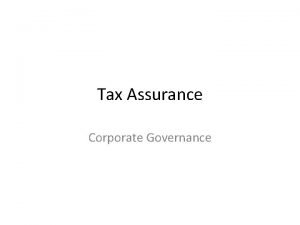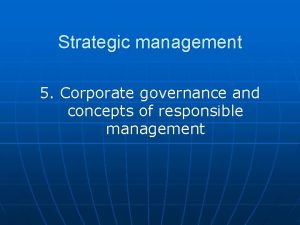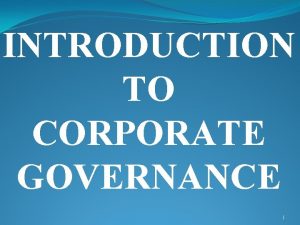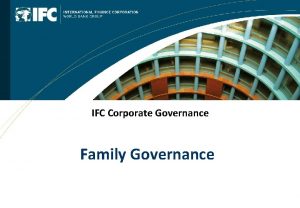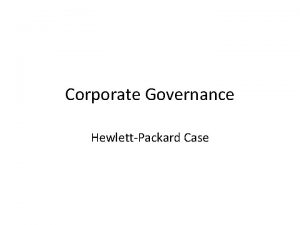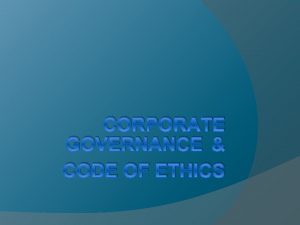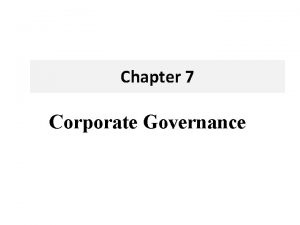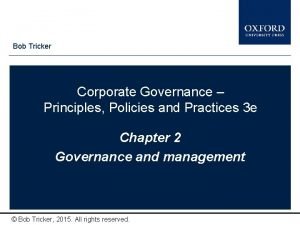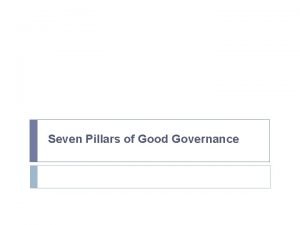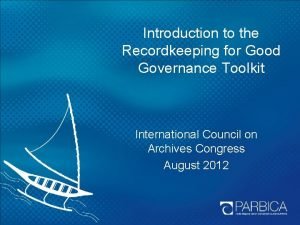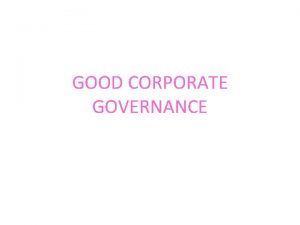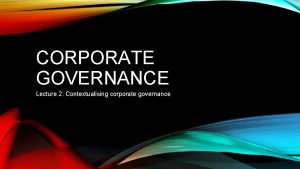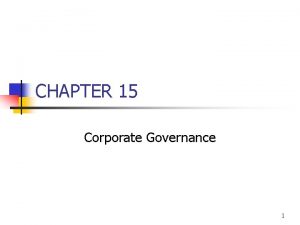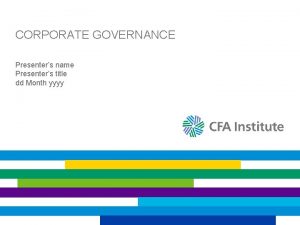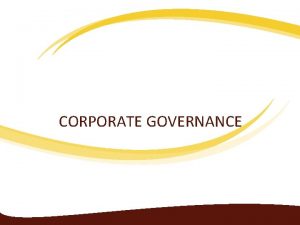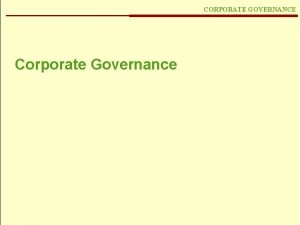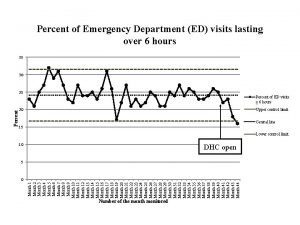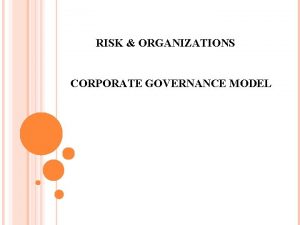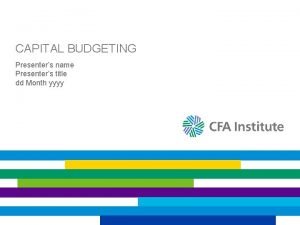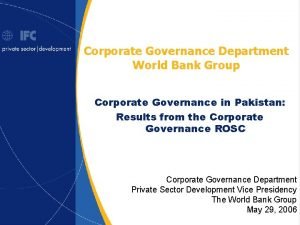CORPORATE GOVERNANCE Presenters name Presenters title dd Month





























- Slides: 29

CORPORATE GOVERNANCE Presenter’s name Presenter’s title dd Month yyyy

1. INTRODUCTION WHAT IS CORPORATE GOVERNANCE? • Corporate governance is the system of principles, policies, procedures, and clearly defined responsibilities and accountabilities used by stakeholders to overcome the conflicts of interest inherent in the corporate form. § Hence, the importance of understanding the different forms of business. • Corporate governance affects the operational risk and, hence, sustainability of a corporation. § The quality of a corporation’s corporate of governance affects the risks and value of the corporation. § Effective, strong corporate governance is essential for the efficient functioning of markets. Copyright © 2013 CFA Institute 2

2. CORPORATE GOVERNANCE: OBJECTIVES AND GUIDING PRINCIPLES • There are inherent conflicts of interest in corporations in which the ownership and management are separate. • Objectives of corporate governance: § To eliminate or mitigate conflicts of interest. - Particularly those between corporate managers and shareholders; and § To ensure that the assets of the company are used efficiently and productively and in the best interests of its investors and other stakeholders. Copyright © 2013 CFA Institute 3

CORE ATTRIBUTES OF AN EFFECTIVE CORPORATE GOVERNANCE SYSTEM Clearly defined manager and director governance responsibilities Identifiable and measureable accountabilities Delineation of rights of shareholders and other stakeholders Fairness and equitable treatment in dealings Copyright © 2013 CFA Institute Transparency and accuracy in disclosures 4

3. FORMS OF BUSINESS AND CONFLICTS OF INTEREST The form of business will dictate, in part, the relationship between the owners of the business and management. § The degree of separation may be minimal (e. g. , sole proprietorship), or significant (e. g. , large corporation). § When there is a separation between owners and managers, there is a potential for agency problems, which may affect the value of the business. § We will examine three business forms: the sole proprietorship, the partnership, and the corporation. Copyright © 2013 CFA Institute 5

SOLE PROPRIETORSHIP • A sole proprietorship is owned and operated by a single person • Sole proprietorships are the most numerous in terms of number of businesses. • Who bears governance risk in a sole proprietorship? § There are few risks with respect to governance from the perspective of the owner. § Creditors, including trade creditors, have the highest risk with respect to governance. Copyright © 2013 CFA Institute 6

PARTNERSHIP • A partnership has two or more owner/managers. • Who bears governance risk in a partnership? § There are few risks with respect to governance from the perspective of the owners, with ownership rights and responsibilities detailed in the partnership agreement. § Creditors, including trade creditors, have the higher risk with respect to governance. Copyright © 2013 CFA Institute 7

CORPORATION • A corporation is a legal entity that has rights similar to an individual. § For example, a corporation can enter into contracts. • Corporations account for most business revenue around the world. § Corporations around the world: Limited Company (U. K. ), Gesellschaft (German); Societé Anonyme (France), 公司 (China); şirket (Turkey); บรษท (Thailand) Copyright © 2013 CFA Institute 8

ADVANTAGES OF THE CORPORATE FORM 1. A corporation can raise capital. § Grant ownership stakes (that is, issue stock) or borrow (that is, issue bonds). 2. Owners need not know how to run the business. § The corporation hires experts to manage the business. 3. Ownership interests are transferrable. Copyright © 2013 CFA Institute 9

DISADVANTAGES OF THE CORPORATE FORM 1. Corporations are more highly regulated than are partnerships or sole proprietorships. § For example, in the U. S. there are State laws pertaining to corporations and the Securities and Exchange Commission requires specific disclosures. 2. Separation of owners and managers. § This is the agency relationship, in which someone (the agent) acts on behalf of another person (the principal). § The potential conflict between owners and managers is the agency problem or principal-agent problem, - Principals: shareholders - Agents: Management and members of the board of directors § There are costs to this agency relationship arising from conflicts of interest. Copyright © 2013 CFA Institute 10

3. FORMS OF BUSINESS AND CONFLICTS OF INTEREST Characteristic Sole Proprietorship Partnership Corporation Ownership Sole owner Multiple owners Unlimited ownership Legal requirements and regulation Legal distinction between owner and business Few; entity easily formed None Liability Unlimited Ability to raise capital Very limited Unlimited but shared among partners Limited Numerous legal requirements Legal separation between owners and business Limited Transferability of ownership Non-transferable (except by sale of entire business) Essential Owner expertise in business Nearly unlimited Non-transferable Easily transferable Essential Unnecessary Exhibit 1 -1, page 4 Copyright © 2013 CFA Institute 11

4. SPECIFIC SOURCES OF CONFLICT: AGENCY RELATIONSHIPS Management–Shareholder conflicts Managers Board of directors Shareholders Director–Shareholder conflicts Copyright © 2013 CFA Institute 12

MANAGEMENT–SHAREHOLDER CONFLICTS • Shareholders entrust management with funds from reinvested earnings or newly issued stock, which management invests. • The overarching objective is to maximize shareholders’ wealth. • Issue: Managers are human § Managers may be more interested in expanding the size of the business, bonuses based on earnings, taking on excessive risks, or job security. § Managers may consume excessive perquisites, or in effect, take advantage of their position to spend excessively on things for themselves. § Bottom line: there may be agency costs in terms of the explicit and implicit costs when managers do not act in the best interest of shareholders. • Effective corporate governance guards against agency costs. Copyright © 2013 CFA Institute 13

DIRECTOR–SHAREHOLDER CONFLICTS • The board of directors are an intermediary between the shareholders and management, and represent shareholders’ interests by: § Monitoring managers; § Approving strategies and policies; § Approving mergers and acquisitions; § Approving audit contracts; § Reviewing audit contracts and financial contracts; § Establishing management compensation; § Disciplining poorly performing managers. • A conflict may arise if the board members align with management. Copyright © 2013 CFA Institute 14

RESPONSIBILITIES OF THE BOARD OF DIRECTORS • Establish corporate values and governance structures for the company; • Ensure that all legal and regulatory requirements are met and complied with fully and in a timely fashion; • Establish long-term strategic objectives for the company; • Establish clear lines of responsibility and a strong system of accountability and performance measurement; • Hire the chief executive officer, determine the compensation package, and periodically evaluate the officer’s performance; • Ensure that management has supplied the board with sufficient information for it to be fully informed and prepared to make the decisions that are its responsibility, and to be able to adequately monitor and oversee the company’s management; • Meet regularly to perform its duties; • Acquire adequate training. Copyright © 2013 CFA Institute 15

5. CORPORATE GOVERNANCE EVALUATION: BOARD OF DIRECTOR ATTRIBUTES • The board should be comprised primarily of independent directors (that is, not insiders) • The Chairman of the Board should be independent; • Directors should be qualified; • There should be a regular election of members of the Board; • There should be a regular self-assessment of the Board; • The board should hold separate meetings of the independent directors; • The board should require audit oversight by independent directors who have sufficient expertise in finance, accounting, and the law. Copyright © 2013 CFA Institute 16

5. CORPORATE GOVERNANCE EVALUATION: BOARD OF DIRECTOR ATTRIBUTES (CONTINUED) • The nominating committee should be comprised of independent directors; • The compensation committee should be comprised of independent directors; • The board should be able to hire outside counsel; • The board should disclose governance policies; • The board should ensure adequate disclosure and transparency; • The board should require disclosure of any related-party transactions; • The board should respond to shareholders’ non-binding proxy votes. Copyright © 2013 CFA Institute 17

MONETARY AUTHORITY OF SINGAPORE GUIDELINES AND REGULATIONS ON CORPORATE GOVERNANCE Principle 1: Every Institution should be headed by an effective Board. Principle 2: There should be a strong and independent element on the Board which is able to exercise objective judgment on corporate affairs independently from management and substantial shareholders. Principle 3: The Board should set and enforce clear lines of responsibility and accountability throughout the Institution. Principle 4: There should be a formal and transparent process for the appointment of new directors to the Board. Principle 5: There should be a formal assessment of the effectiveness of the Board as a whole and the contribution by each director to the effectiveness of the Board. Principle 6: In order to fulfill their responsibilities, Board members should be provided with complete, adequate and timely information prior to board meetings and on an on-going basis by the management. Copyright © 2013 CFA Institute 18

GUIDELINES AND REGULATIONS ON CORPORATE GOVERNANCE (CONTINUED) Principle 7: There should be a formal and transparent procedure for fixing the remuneration packages of individual directors. No director should be involved in deciding his own remuneration. Principle 8: The level and composition of remuneration should be appropriate to attract, retain and motivate the directors to perform their roles and carry out their responsibilities. Principle 9: The Board should establish an Audit Committee with a set of written terms of reference that clearly sets out its authority and duties. Principle 10: The Board should ensure that there is an adequate risk management system and sound internal controls. Copyright © 2013 CFA Institute 19

GUIDELINES AND REGULATIONS ON CORPORATE GOVERNANCE (CONTINUED) Principle 11: The Board should ensure that an internal audit function that is independent of the activities audited is established. Principle 12: The Board should ensure that management formulates policies to ensure dealings with the public, the Institution’s policyholders and claimants, depositors and other customers are conducted fairly, responsibly and professionally. Principle 13: The Board should ensure that related party transactions with the Institution are made on an arm’s length basis. Copyright © 2013 CFA Institute 20

ORGANISATION FOR ECONOMIC CO-OPERATION AND DEVELOPMENT (OECD) PRINCIPLES OF CORPORATE GOVERNANCE I II IV V • The rights of shareholders • The equitable treatment of shareholders • The role of stakeholders in corporate governance • Disclosure and transparency • The responsibilities of the board Copyright © 2013 CFA Institute 21

6. ENVIRONMENTAL, SOCIAL, AND GOVERNANCE FACTORS ESG risk exposure • Environmental, social, and governance (ESG) risk is the risk associated with the management of environment, social, and governance issues. - Involves mitigating risks and managing these risks when they arise. • ESG risk affects the company’s sustainability and valuation. Environment • Pollution • Disclosures Copyright © 2013 CFA Institute Social • Workplace issues • Product quality and safety • Community interaction Governance • Effective governance 22

EXAMPLES OF ESG RISKS • Legislative and regulatory risk (that is, the role of governments) • Legal risk (for example, lawsuits) • Reputational risk • Operating risk • Financial risk Copyright © 2013 CFA Institute 23

7. VALUATION IMPLICATIONS OF CORPORATE GOVERNANCE Benefits from a strong corporate governance Risks of weak corporate governance Copyright © 2013 CFA Institute 24

RISKS OF WEAK CORPORATE GOVERNANCE Accounting risk • The risk that a company’s financial statement recognition and related disclosures are incomplete, misleading, or materially misstated. Copyright © 2013 CFA Institute Asset risk Liability risk • The risk that the firm’s assets may be misappropriated by managers or directors. • The risk that management will enter into excessive obligations that destroy the value of shareholders’ equity. Strategic policy risk • The risk that managers may enter into transactions or incur other business risks that are selfserving and may not be in the best long-term interest of shareholders. 25

BENEFITS FROM STRONG GOVERNANCE Evidence suggests that: § companies with strong governance had greater investment performance. § companies with strong shareholders’ rights outperformed those with weak protections. Copyright © 2013 CFA Institute 26

8. SUMMARY § Corporate governance is the system of principles, policies, procedures, and clearly defined responsibilities and accountabilities. § The objectives of a corporate governance system are (1) to eliminate or mitigate conflicts of interest among stakeholders, particularly between managers and shareholders, and (2) to ensure that the assets of the company are used efficiently and productively and in the best interests of the investors and other stakeholders. § The failure of a company to establish an effective system of corporate governance represents a major operational risk to the company and its investors. Copyright © 2013 CFA Institute 27

SUMMARY (CONTINUED) • The specific sources of conflict in corporate agency relationships are managershareholder. • The responsibilities of board members, both individually and as a group, are to establish corporate values and effective governance structures for the company. Copyright © 2013 CFA Institute 28

SUMMARY (CONTINUED) • Companies committed to corporate governance often provide a statement of corporate governance policies. Analysts should assess: § the code of ethics; statements of the oversight, monitoring, and review responsibilities of directors; § statements of management’s responsibilities with respect to information and access of directors to internal company functions; § reports of directors’ examinations, evaluations, and findings; § board and committee self-assessments; management self-assessments; and § training policies for directors. • Weak corporate governance systems give rise to risks including accounting risk, asset risk, liability risk, and strategic policy risk. Copyright © 2013 CFA Institute 29
 Goal of corporate finance
Goal of corporate finance Month of aviv
Month of aviv Sidereal month vs synodic month
Sidereal month vs synodic month What is the name of the presenter
What is the name of the presenter Annoying create and craft presenters
Annoying create and craft presenters Presentation name
Presentation name Job title example
Job title example Name/title of presenter
Name/title of presenter Sociological theory of corporate governance
Sociological theory of corporate governance Tax assurance
Tax assurance What is ownership
What is ownership Internal governance mechanisms
Internal governance mechanisms Isu dan riset kontemporer corporate governance
Isu dan riset kontemporer corporate governance Corporate governance purpose
Corporate governance purpose Family governance definition
Family governance definition Corporate governance in sri lanka
Corporate governance in sri lanka Cmda corporate governance code
Cmda corporate governance code Hp corporate governance
Hp corporate governance P&g corporate governance
P&g corporate governance Defination of corporate governance
Defination of corporate governance Corporate governance in strategic management
Corporate governance in strategic management Tricker model of corporate governance
Tricker model of corporate governance Corporate governance approaches
Corporate governance approaches Four pillars of governance
Four pillars of governance Corporate governance is a form of
Corporate governance is a form of Corporate governance tool kit
Corporate governance tool kit Good governance and corporate social responsibility
Good governance and corporate social responsibility Latar belakang munculnya good corporate governance
Latar belakang munculnya good corporate governance Corporate governance lecture
Corporate governance lecture Potential problems in corporate governance
Potential problems in corporate governance









